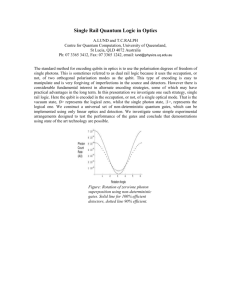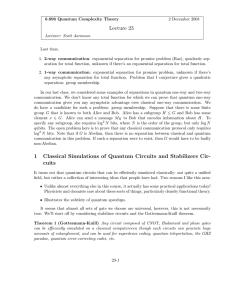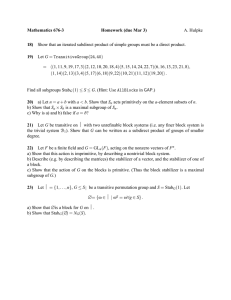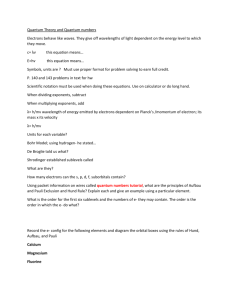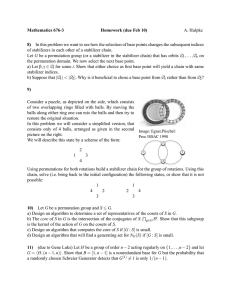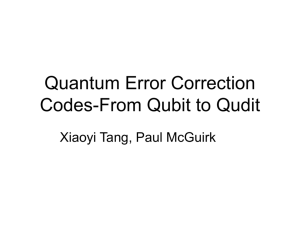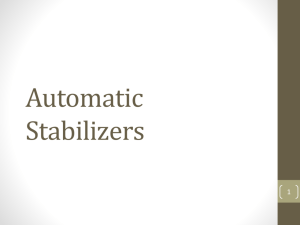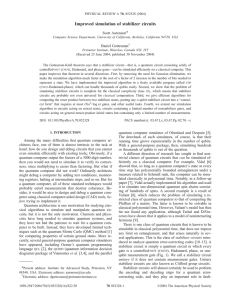MASSACHUSETTS INSTITUE OF TECHNOLOGY
advertisement
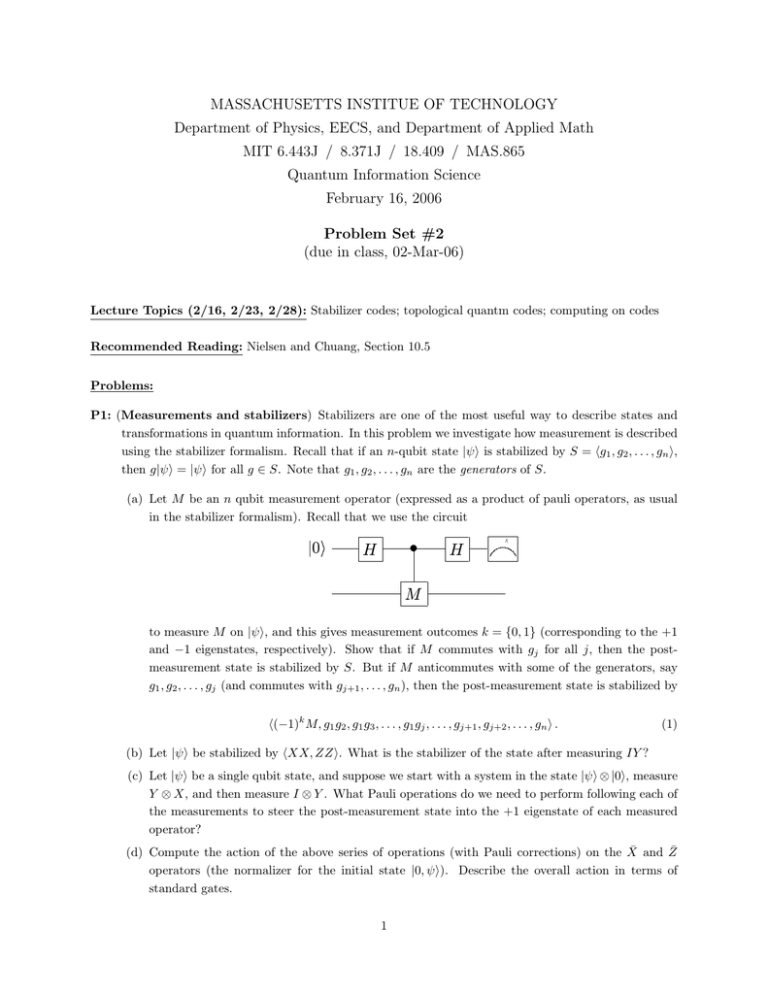
MASSACHUSETTS INSTITUE OF TECHNOLOGY
Department of Physics, EECS, and Department of Applied Math
MIT 6.443J / 8.371J / 18.409 / MAS.865
Quantum Information Science
February 16, 2006
Problem Set #2
(due in class, 02­Mar­06)
Lecture Topics (2/16, 2/23, 2/28): Stabilizer codes; topological quantm codes; computing on codes
Recommended Reading: Nielsen and Chuang, Section 10.5
Problems:
P1: (Measurements and stabilizers) Stabilizers are one of the most useful way to describe states and
transformations in quantum information. In this problem we investigate how measurement is described
using the stabilizer formalism. Recall that if an n­qubit state |ψ� is stabilized by S = �g1 , g2 , . . . , gn �,
then g|ψ� = |ψ� for all g ∈ S. Note that g1 , g2 , . . . , gn are the generators of S.
(a) Let M be an n qubit measurement operator (expressed as a product of pauli operators, as usual
in the stabilizer formalism). Recall that we use the circuit
________
L _ ____ ___
to measure M on |ψ�, and this gives measurement outcomes k = {0, 1} (corresponding to the +1
and −1 eigenstates, respectively). Show that if M commutes with gj for all j, then the post­
measurement state is stabilized by S. But if M anticommutes with some of the generators, say
g1 , g2 , . . . , gj (and commutes with gj+1 , . . . , gn ), then the post­measurement state is stabilized by
�(−1)k M, g1 g2 , g1 g3 , . . . , g1 gj , . . . , gj+1 , gj+2 , . . . , gn � .
(1)
(b) Let |ψ� be stabilized by �XX, ZZ�. What is the stabilizer of the state after measuring IY ?
(c) Let |ψ� be a single qubit state, and suppose we start with a system in the state |ψ� ⊗ |0�, measure
Y ⊗ X, and then measure I ⊗ Y . What Pauli operations do we need to perform following each of
the measurements to steer the post­measurement state into the +1 eigenstate of each measured
operator?
¯ and Z¯
(d) Compute the action of the above series of operations (with Pauli corrections) on the X
operators (the normalizer for the initial state |0, ψ�). Describe the overall action in terms of
standard gates.
1
√
(e) Suppose we had started with the input state |ψ� ⊗ (|0� + |1�)/ 2 instead, and performed the same
two measurements. What would have happened then?
P2: (Passive error correction and decoherence free subspaces) Quantum error correction is an ex­
ample of “active” error correction where one first detects whether an error occurs and then applies
a correcting operation. An interesting area of research in quantum information is the possibility of
“passive” error correction. We explore in this problem one of these possibilities, Decoherence Free or
Noiseless Subspaces (DFS), in the context of stabilizer codes.
Recall the following:
• If S is the stabilizer for the code C, then ∀V ∈ S, and ∀|ψ� ∈ C, V |ψ� = |ψ�.
• If N (G) is the normalizer for the group G, then ∀U ∈ N and ∀V ∈ G, U V U † ∈ G
As an example, we will use the three qubit bit flip code, Cbf , where |0L � = |000� and |1L � = |111�.
The stabilizer S is generated by ZZI and IZZ, that is S = �ZZI, IZZ�
(a) Using the stabilizer formalism, show that the code can correct the errors E1 = XII, E2 = IXI
and E3 = IIX.
(b) Now assume that instead of single qubit bit flips, the error is E1 = ZIZ. Show that no error
correction or detection is necessary; E1 causes no errors. This is an example of the DFS condition;
we say that |ψ� is in the DFS for errors {Ej } iff ∀j, Ej |ψ� = cj |ψ�, where cj is a constant
independent of |ψ�.
(c) Show that in general, a code C is a DFS for the set of errors Ei if all the Ei are in the stabilizer
of C.
(d) Show that there is no code for which all single qubit errors form the stabilizer.
(e) Let U1 and U2 be two quantum gates s.t. U2 U1 = XL where XL is a logical bit flip for the three
qubit bit flip code (i.e. XL |0L � = |1L � and XL |1L � = |0L �). For Cbf , we choose two sets of unitaries
that satisfy this condition A = {U1 = Y Y Y, U2 = ZZZ} and B = {U1 = ZY X, U2 = Y ZI}.
Show that U1 U2 = XL for both sets A and B.
(f) We now examine the effect of errors. Assume that instead of the desired circuit, the following
operation occurs: U2 E1 U1 .
In the QECC model, show that the error E1 = XII can be detected and corrected for both sets
A and B. Also show that in the DFS model, the error E1 = ZIZ is “passively” corrected for set
A and uncorrectable for set B.
(g) For a general code, given an arbitrary error E, what is the condition on U1 and U2 such that
U2 EU1 can be corrected using QECC techniques? Express in terms of stabilizers and normalizers.
(h) For a general code C which is a DFS for errors {Ej } , what is the condition on U1 and U2 such
that the DFS condition will hold for U2 Ej U1 , ∀j? Express in terms of stabilizers and normalizers.
P3: (Topological QEC: Projective Plane Codes) Quantum error correction codes can be constructed
using graphs on topological surfaces, where vertices and edges correspond to certain stabilizer opera­
tions, and the distance of the code is given by the shortest non­trivial topological chain of errors. In
this problem, we explore a specific instance of such a construction, on a projective plane.
2
(a) The projective plane in two dimensions, �P 2 , can be drawn as a disc in which antipodal points
on the boundary are identified. Recall that a cellulation C of a surface defines sets F , E, and V
of faces, edges, and vertices. For each e ∈ E, there corresponds a qubit on which Xe and Ze are
the Pauli X and Z operators. Let Ef ⊂ E be the set of edges around face f ∈ F , and let Ev ⊂ E
be the set of edges attached to vertex v ∈ V . For the set of all f and v, we define
Af =
�
Ze
and
e∈Ef
Bv =
�
Xe ;
(2)
e∈Ev
these are the stabilizers for the code. Give the three Af and single unique Bv for the cellulation:
1
A
2
B
3
4
C
This code encodes four qubits (|E | = 4), corresponding to the four edges, labeled 1 through 4.
Note there are only three distinct faces, labeled A, B, and C. Verify that the stabilizers commute.
What state(s) do they stabilize?
(b) Give the stabilizers for the cellulation:
What codewords are stabilized by these stabilizers?
(c) The dual, C ∗ , to a cellulation C places vertices in middle of each face of C, and edges perpendicular
to the edges of C, connecting the new vertices. Give the dual to the two cellulations above, and
the codewords which are stabilized.
(d) Prove that a cellulation is valid, i.e. it gives a set of stabilizers producing a well­defined code,
only when each vertex has distinct edges, and no edge has the same face on both of its sides.
(e) Can you construct a valid five edge cellulation of the projective plane?
P4: (The Gottesman­Knill Theorem) An important result in quantum computation is that H, CNOT,
and the Pauli gates are not universal for quantum computation, and in fact any quantum circuit com­
posed from those gates (together with standard input states and measurements in the computational
basis) can be simulated efficiently by a classical computer! This result is known as the Gottesman­Knill
theorem, and in this problem we prove the essential result behind the theorem.
3
Let Gn denote the Pauli group on n qubits, that is, matrix multiplication acting on the set of n­fold
tensor products of Pauli matrices (including multiplicative factors ±1, ±i). By definition, we say the
set of U such that U Gn U † = Gn is the normalizer of Gn , and denote it by N (Gn ). The following
theorem about the normalizer of the Pauli group holds:
Suppose U is any unitary operator on n qubits with the property that if g ∈ Gn then
U gU † ∈ Gn . Then up to a global phase U may be composed from O(n2 ) Hadamard, phase
and controlled­not gates.
We can construct an inductive proof of this theorem as follows:
(a) Prove that the Hadamard and phase gates (H and S) can be used to perform any normalizer
operation on a single qubit.
(b) Suppose U is an n + 1 qubit gate in N (Gn+1 ) such that U Z1 U † = X1 ⊗ g and U X1 U † = Z1 ⊗ g �
√
for some g, g � ∈ Gn . Define U � on n qubits by U � |ψ� ≡ 2�0|U (|0� ⊗ |ψ�). Use the inductive
hypothesis to show that this construction for U :
may be implemented using O(n2 ) Hadamard, phase and controlled­not gates.
(c) Show that any gate U ∈ N (Gn+1 ) may be implemented using O(n2 ) Hadamard, phase and
controlled­not gates.
4
